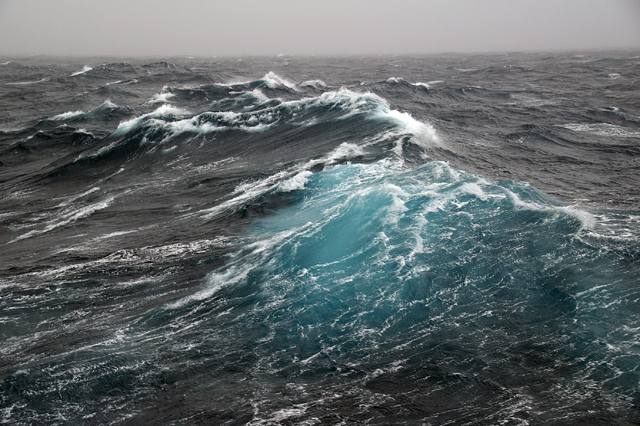With help from China, CSIRO is reasserting its leading position in Southern Hemisphere climate science.

The Southern Ocean, engine room of the global ocean. PHOTO Steve Rintoul
CSIRO is back in town and back on the world climate research stage. That was the real news in yesterday’s welcome announcement of a new Hobart-based Centre for Southern Hemisphere Oceans Research.
The centre, which has the nifty acronym CSHOR (seashore), is financially supported by China’s largest marine science research institute, Qingdao National Laboratory for Marine Science and Technology (QNLM).
The full funding commitment for CSHOR is $20 million over 10 years, half of which will come from China. Two Australian universities, Tasmania and New South Wales, are also contributors, offering shared facilities and personnel.
The funding is modest, but the important point is the international connection, which will offer some protection against any further CSIRO funding cuts.
This is just what was needed after CSIRO’s decision early last year to cut climate research resources on grounds that it needed those resources to respond to a government drive for commercially-driven science.
Within a week of the decision’s announcement, thousands of climate scientists from around the world had put their names to a letter to the prime minister, Malcolm Turnbull, pointing out the critical importance of CSIRO’s multi-decadal investigation of Southern Hemisphere climate.
At the same time, some senior CSIRO scientists were questioning their board and chief executive, Larry Marshall, over declining to put in a submission on Australian climate policy. One of those scientists was world-leading sea level specialist John Church, who was sacked last May.
There was an immediate outcry over the sacking. Responding to the bad press, new science minister Greg Hunt issued a statement that “public good” research into climate change was here to stay.
Extra money was found and plans put together, and in March this year senior CSIRO atmospheric scientist Helen Cleugh took charge of a rebadged CSIRO climate research program, in which remaining climate scientists and programs came together in a new Climate Change Centre.
Key to the development of both CSHOR and the parent Climate Change Centre has been ocean scientist Steve Rintoul, whose long CSIRO career is approaching 30 years. He doesn’t talk about it, but my judgment is that he was an important steadying influence through some troubled times.
It will be fascinating to see how CSHOR’s Chinese connection develops over time. Qingdao, on the southern coast of the Shandong Peninsula roughly halfway between Beijing and Shanghai, is a major Chinese port city with a long maritime history.
QNLM is a brand new institution being installed there by national, provincial and city governments. The aim is to make it a world-leading marine science institution, and given its financial and other resources (its workforce is already as big as CSIRO’s) that seems very likely.
The blend of QNLM resources and CSIRO’s decades of marine science experience looks propitious for both institutions. China is investing heavily in doing marine science, and CSHOR offers it a lot of hard-earned knowledge about ocean processes in southern regions.
CSHOR is a recognition by both governments of the fundamental importance of the global ocean, which covers more than 70 per cent of Earth’s surface, in Earth’s climate system. It takes up a quarter of our excess carbon dioxide from the air and over 90 per cent of excess heat energy.
Most of the world’s ocean waters are in the Southern Hemisphere, where fierce westerly winds drive huge currents which power the world’s ocean circulation. For marine scientists, the global action is here.
Both China and Australia are directly affected by two climate processes: the El Nino–Southern Oscillation, originating in the tropical Pacific, and an Indian Ocean phenomenon known as the Indian Ocean Dipole. These will be a key focus of the new centre’s work.
In announcing the initiative yesterday, Larry Marshall said CSHOR would study the oceans from the tropics (including Northern Hemisphere tropics) to Antarctica and “tackle fundamental questions about the future climate of Australia, China and the rest of the world.”
He described the Chinese involvement as an “exciting opportunity”, a sentiment shared by QNLM director Professor Lixin Wu, who said he looked forward to working with CSIRO “in helping China, Australia and the rest of the world to better tackle and adjust to climate changes.”
It’s a relief to hear such positive sentiments from Larry Marshall. Sixteen months ago he said CSIRO would now focus on “delivering outcomes” because the question of climate change was “definitively answered” – a very unscientific response to the most complex science of all.
Any student of the scientific method will tell you that science is driven by questions and the testing of those questions against evidence, and cannot give definitive answers. It is slowly opening our eyes to the vast, intricate Earth system, but the process can never be complete.
Marshall said back then that CSIRO’s climate measurers and modellers “might not be the right people to figure out how to adapt [to climate]”. But without good data and well-constructed, evolving models, planned adaptation will be impossible. We’ll be flying blind.
But if the CSIRO board and chief executive slipped up, big institutions have ways of sorting these things out. Like the Earth system, CSIRO is a complex beast with a long history of multitasking.
While Marshall’s digital innovation program ramps up – and good luck to it – the arrival of the Climate Science Centre and CSHOR seems just what’s needed to put CSIRO back in its world-leading position in Southern Hemisphere climate science.
Another positive development: as it happens, the two Australian universities supporting CSHOR (NSW and Tasmania) have both engaged the expert services of John Church. So maybe, after all the trauma of 2016, things might turn out better than ever. Who would have thought it?
